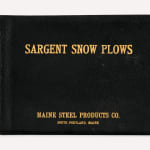[Sargent Snow Plows]
Company Album Showcasing the Successful Clearing of the Treacherous Wolf Creek Pass in the Colorado Rockies, 1932
Photo album; silver prints (17)
Each 7 x 9 inches
Also includes a printed diagram.
Also includes a printed diagram.
Sold
Further images
-
(View a larger image of thumbnail 1
)

-
(View a larger image of thumbnail 2
)

-
(View a larger image of thumbnail 3
)

-
(View a larger image of thumbnail 4
)

-
(View a larger image of thumbnail 5
)

-
(View a larger image of thumbnail 6
)

-
(View a larger image of thumbnail 7
)

-
(View a larger image of thumbnail 8
)

-
(View a larger image of thumbnail 9
)

-
(View a larger image of thumbnail 10
)

-
(View a larger image of thumbnail 11
)

Company album showcasing the Maine-based Sargent Snow Plow’s successful attempt at clearing the treacherous Wolf Creek Pass in the Colorado Rockies after the heaviest snowfall since 1883, which culminated in...
Company album showcasing the Maine-based Sargent Snow Plow’s successful attempt at clearing the treacherous Wolf Creek Pass in the Colorado Rockies after the heaviest snowfall since 1883, which culminated in snow drifts as high as 30 feet!
Where all previous attempts to plow had failed, the Sargent reigned supreme. Delivered from Portland, Maine to the San Juan Mountains of Colorado, and operated by two New Englanders, the heavy duty plow passed muster in March, 1932 facing a true test of its competence and efficiency. Up against harsh conditions; “40 degrees below zero, 10,850 ft. above sea level, snow 14 to 30 feet deep, and a 100 to 150 foot drop on the outside [of the pass],” the hydraulic plow powered through, using the infinitely adjustable “Sargent Wing” and precisely designed “Deep V”. Clearing the pass in just ten days they had accomplished what was prior considered impossible. Proving the Sargent’s capabilities won the company an order with the Colorado State Highway Department to acquire a new plow at the cost of $3026.59.
The album opens with a graphically-composed photomontage identifying “The Job,” “The Plow,” and “The Order” and a humorously defiant admission that “The Rockies scrubbed off the famous Sargent color scheme-but the plow was still all there. No repairs necessary.” Following this, a photomontaged page of newspaper clippings with headlines such as “Man Conquers Nature’s Icy Barriers” and “Snow Plows Conquer Wolf Creek Pass Ice”. The remainder of the album comprises a 15 photograph documentation of the task at hand, each replete with a detailed caption stating the challenges faced and descriptions of the plow's features that enabled it to prevail over them.
Where all previous attempts to plow had failed, the Sargent reigned supreme. Delivered from Portland, Maine to the San Juan Mountains of Colorado, and operated by two New Englanders, the heavy duty plow passed muster in March, 1932 facing a true test of its competence and efficiency. Up against harsh conditions; “40 degrees below zero, 10,850 ft. above sea level, snow 14 to 30 feet deep, and a 100 to 150 foot drop on the outside [of the pass],” the hydraulic plow powered through, using the infinitely adjustable “Sargent Wing” and precisely designed “Deep V”. Clearing the pass in just ten days they had accomplished what was prior considered impossible. Proving the Sargent’s capabilities won the company an order with the Colorado State Highway Department to acquire a new plow at the cost of $3026.59.
The album opens with a graphically-composed photomontage identifying “The Job,” “The Plow,” and “The Order” and a humorously defiant admission that “The Rockies scrubbed off the famous Sargent color scheme-but the plow was still all there. No repairs necessary.” Following this, a photomontaged page of newspaper clippings with headlines such as “Man Conquers Nature’s Icy Barriers” and “Snow Plows Conquer Wolf Creek Pass Ice”. The remainder of the album comprises a 15 photograph documentation of the task at hand, each replete with a detailed caption stating the challenges faced and descriptions of the plow's features that enabled it to prevail over them.
![[Sargent Snow Plows], Company Album Showcasing the Successful Clearing of the Treacherous Wolf Creek Pass in the Colorado Rockies, 1932](https://artlogic-res.cloudinary.com/w_1600,h_1600,c_limit,f_auto,fl_lossy,q_auto/artlogicstorage/dollc/images/view/ed6b47c78582164296d1f7a9257b3003j/daniel-oliver-sargent-snow-plows-company-album-showcasing-the-successful-clearing-of-the-treacherous-wolf-creek-pass-in-the-colorado-rockies-1932.jpg)
![[Sargent Snow Plows], Company Album Showcasing the Successful Clearing of the Treacherous Wolf Creek Pass in the Colorado Rockies, 1932](https://artlogic-res.cloudinary.com/w_1600,h_1600,c_limit,f_auto,fl_lossy,q_auto/artlogicstorage/dollc/images/view/dc878f2972b5e04ab3cf512b8198d5d2j/daniel-oliver-sargent-snow-plows-company-album-showcasing-the-successful-clearing-of-the-treacherous-wolf-creek-pass-in-the-colorado-rockies-1932.jpg)
![[Sargent Snow Plows], Company Album Showcasing the Successful Clearing of the Treacherous Wolf Creek Pass in the Colorado Rockies, 1932](https://artlogic-res.cloudinary.com/w_1600,h_1600,c_limit,f_auto,fl_lossy,q_auto/artlogicstorage/dollc/images/view/f5fcc69c8f14730b34cbe0661b615e13j/daniel-oliver-sargent-snow-plows-company-album-showcasing-the-successful-clearing-of-the-treacherous-wolf-creek-pass-in-the-colorado-rockies-1932.jpg)
![[Sargent Snow Plows], Company Album Showcasing the Successful Clearing of the Treacherous Wolf Creek Pass in the Colorado Rockies, 1932](https://artlogic-res.cloudinary.com/w_1600,h_1600,c_limit,f_auto,fl_lossy,q_auto/artlogicstorage/dollc/images/view/2bf9971ea5516f44667588067e1a8af8j/daniel-oliver-sargent-snow-plows-company-album-showcasing-the-successful-clearing-of-the-treacherous-wolf-creek-pass-in-the-colorado-rockies-1932.jpg)
![[Sargent Snow Plows], Company Album Showcasing the Successful Clearing of the Treacherous Wolf Creek Pass in the Colorado Rockies, 1932](https://artlogic-res.cloudinary.com/w_1600,h_1600,c_limit,f_auto,fl_lossy,q_auto/artlogicstorage/dollc/images/view/2ccc4514c1a32468389259f9b0a883a3j/daniel-oliver-sargent-snow-plows-company-album-showcasing-the-successful-clearing-of-the-treacherous-wolf-creek-pass-in-the-colorado-rockies-1932.jpg)
![[Sargent Snow Plows], Company Album Showcasing the Successful Clearing of the Treacherous Wolf Creek Pass in the Colorado Rockies, 1932](https://artlogic-res.cloudinary.com/w_1600,h_1600,c_limit,f_auto,fl_lossy,q_auto/artlogicstorage/dollc/images/view/8d0fcdb330a0e50e9c27f4e828da294dj/daniel-oliver-sargent-snow-plows-company-album-showcasing-the-successful-clearing-of-the-treacherous-wolf-creek-pass-in-the-colorado-rockies-1932.jpg)
![[Sargent Snow Plows], Company Album Showcasing the Successful Clearing of the Treacherous Wolf Creek Pass in the Colorado Rockies, 1932](https://artlogic-res.cloudinary.com/w_1600,h_1600,c_limit,f_auto,fl_lossy,q_auto/artlogicstorage/dollc/images/view/65ff7d2923bd4115c659d60102c2fa79j/daniel-oliver-sargent-snow-plows-company-album-showcasing-the-successful-clearing-of-the-treacherous-wolf-creek-pass-in-the-colorado-rockies-1932.jpg)
![[Sargent Snow Plows], Company Album Showcasing the Successful Clearing of the Treacherous Wolf Creek Pass in the Colorado Rockies, 1932](https://artlogic-res.cloudinary.com/w_1600,h_1600,c_limit,f_auto,fl_lossy,q_auto/artlogicstorage/dollc/images/view/a13285e195ae752b4a1d73ea26f0b3b8j/daniel-oliver-sargent-snow-plows-company-album-showcasing-the-successful-clearing-of-the-treacherous-wolf-creek-pass-in-the-colorado-rockies-1932.jpg)
![[Sargent Snow Plows], Company Album Showcasing the Successful Clearing of the Treacherous Wolf Creek Pass in the Colorado Rockies, 1932](https://artlogic-res.cloudinary.com/w_1600,h_1600,c_limit,f_auto,fl_lossy,q_auto/artlogicstorage/dollc/images/view/91de3de14e1b82587cf421b4b0941a90j/daniel-oliver-sargent-snow-plows-company-album-showcasing-the-successful-clearing-of-the-treacherous-wolf-creek-pass-in-the-colorado-rockies-1932.jpg)
![[Sargent Snow Plows], Company Album Showcasing the Successful Clearing of the Treacherous Wolf Creek Pass in the Colorado Rockies, 1932](https://artlogic-res.cloudinary.com/w_1600,h_1600,c_limit,f_auto,fl_lossy,q_auto/artlogicstorage/dollc/images/view/02b305dbb1d8994a6f8afbe30fb6850aj/daniel-oliver-sargent-snow-plows-company-album-showcasing-the-successful-clearing-of-the-treacherous-wolf-creek-pass-in-the-colorado-rockies-1932.jpg)
![[Sargent Snow Plows], Company Album Showcasing the Successful Clearing of the Treacherous Wolf Creek Pass in the Colorado Rockies, 1932](https://artlogic-res.cloudinary.com/w_1600,h_1600,c_limit,f_auto,fl_lossy,q_auto/artlogicstorage/dollc/images/view/f41a7e2b932ae21ae96acc1473df352dj/daniel-oliver-sargent-snow-plows-company-album-showcasing-the-successful-clearing-of-the-treacherous-wolf-creek-pass-in-the-colorado-rockies-1932.jpg)